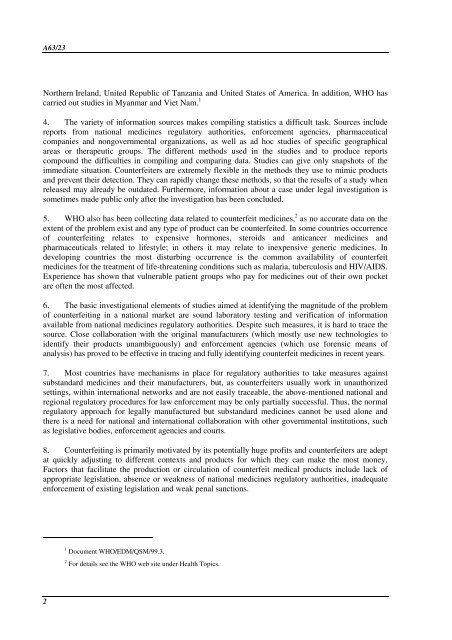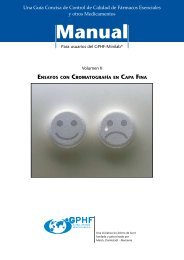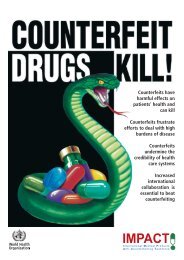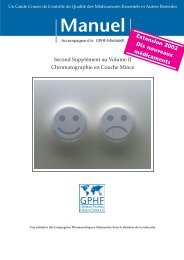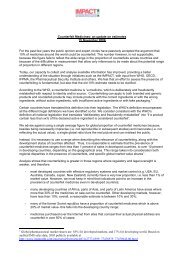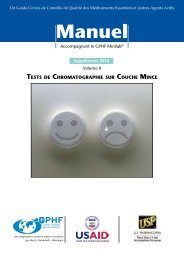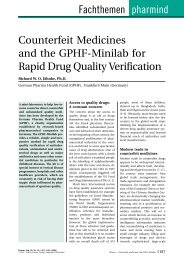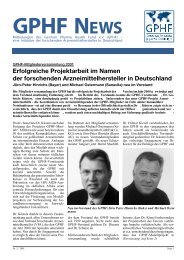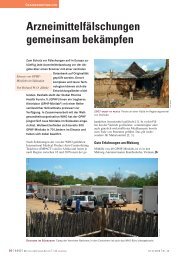Counterfeit Medical Products, Report by the Secretariat
Counterfeit Medical Products, Report by the Secretariat
Counterfeit Medical Products, Report by the Secretariat
Create successful ePaper yourself
Turn your PDF publications into a flip-book with our unique Google optimized e-Paper software.
A63/23<br />
Nor<strong>the</strong>rn Ireland, United Republic of Tanzania and United States of America. In addition, WHO has<br />
carried out studies in Myanmar and Viet Nam. 1<br />
4. The variety of information sources makes compiling statistics a difficult task. Sources include<br />
reports from national medicines regulatory authorities, enforcement agencies, pharmaceutical<br />
companies and nongovernmental organizations, as well as ad hoc studies of specific geographical<br />
areas or <strong>the</strong>rapeutic groups. The different methods used in <strong>the</strong> studies and to produce reports<br />
compound <strong>the</strong> difficulties in compiling and comparing data. Studies can give only snapshots of <strong>the</strong><br />
immediate situation. <strong>Counterfeit</strong>ers are extremely flexible in <strong>the</strong> methods <strong>the</strong>y use to mimic products<br />
and prevent <strong>the</strong>ir detection. They can rapidly change <strong>the</strong>se methods, so that <strong>the</strong> results of a study when<br />
released may already be outdated. Fur<strong>the</strong>rmore, information about a case under legal investigation is<br />
sometimes made public only after <strong>the</strong> investigation has been concluded.<br />
5. WHO also has been collecting data related to counterfeit medicines, 2 as no accurate data on <strong>the</strong><br />
extent of <strong>the</strong> problem exist and any type of product can be counterfeited. In some countries occurrence<br />
of counterfeiting relates to expensive hormones, steroids and anticancer medicines and<br />
pharmaceuticals related to lifestyle; in o<strong>the</strong>rs it may relate to inexpensive generic medicines. In<br />
developing countries <strong>the</strong> most disturbing occurrence is <strong>the</strong> common availability of counterfeit<br />
medicines for <strong>the</strong> treatment of life-threatening conditions such as malaria, tuberculosis and HIV/AIDS.<br />
Experience has shown that vulnerable patient groups who pay for medicines out of <strong>the</strong>ir own pocket<br />
are often <strong>the</strong> most affected.<br />
6. The basic investigational elements of studies aimed at identifying <strong>the</strong> magnitude of <strong>the</strong> problem<br />
of counterfeiting in a national market are sound laboratory testing and verification of information<br />
available from national medicines regulatory authorities. Despite such measures, it is hard to trace <strong>the</strong><br />
source. Close collaboration with <strong>the</strong> original manufacturers (which mostly use new technologies to<br />
identify <strong>the</strong>ir products unambiguously) and enforcement agencies (which use forensic means of<br />
analysis) has proved to be effective in tracing and fully identifying counterfeit medicines in recent years.<br />
7. Most countries have mechanisms in place for regulatory authorities to take measures against<br />
substandard medicines and <strong>the</strong>ir manufacturers, but, as counterfeiters usually work in unauthorized<br />
settings, within international networks and are not easily traceable, <strong>the</strong> above-mentioned national and<br />
regional regulatory procedures for law enforcement may be only partially successful. Thus, <strong>the</strong> normal<br />
regulatory approach for legally manufactured but substandard medicines cannot be used alone and<br />
<strong>the</strong>re is a need for national and international collaboration with o<strong>the</strong>r governmental institutions, such<br />
as legislative bodies, enforcement agencies and courts.<br />
8. <strong>Counterfeit</strong>ing is primarily motivated <strong>by</strong> its potentially huge profits and counterfeiters are adept<br />
at quickly adjusting to different contexts and products for which <strong>the</strong>y can make <strong>the</strong> most money.<br />
Factors that facilitate <strong>the</strong> production or circulation of counterfeit medical products include lack of<br />
appropriate legislation, absence or weakness of national medicines regulatory authorities, inadequate<br />
enforcement of existing legislation and weak penal sanctions.<br />
1 Document WHO/EDM/QSM/99.3.<br />
2 For details see <strong>the</strong> WHO web site under Health Topics.<br />
2


